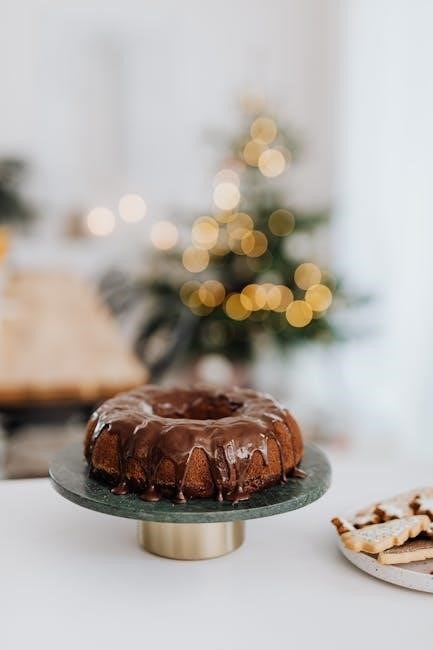Welcome to the Cake Serving Guide! Discover essentials for planning perfect portions, from standard serving sizes to expert slicing techniques. Learn how cake shape, tiers, and portion sizes impact servings for any event.
Understanding Standard Cake Serving Sizes
Standard cake serving sizes vary, with dessert portions typically measuring 1×2 inches and party portions slightly larger at 1.5×2 inches, ensuring consistent slicing for any event.
Normal Serving Size for Dessert
A normal dessert serving size is typically a slice measuring 1 inch wide at its widest point and 2 inches deep for a 2-layer cake. This standard ensures each guest receives a generous yet manageable portion, balancing flavor and presentation. The measurement is consistent across round and square cakes, though shapes may affect visual perception. For desserts, this size is ideal as it complements other menu items without overwhelming the palate. The 1×2-inch slice is widely accepted as the benchmark, offering a delightful treat that satisfies without excess. This sizing also helps in planning and ensures even distribution during events.
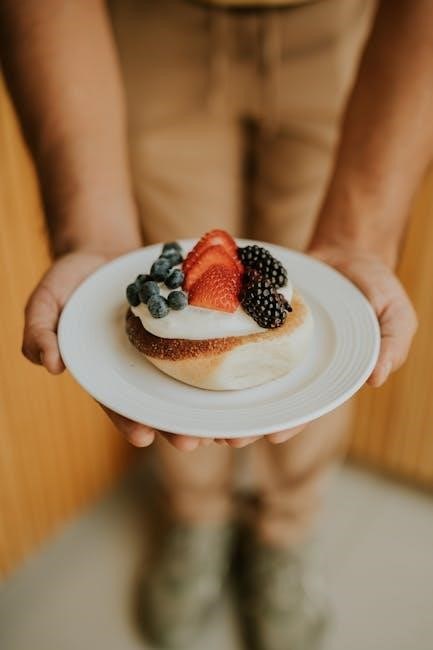
Party vs. Wedding Portion Sizes
Party and wedding portion sizes differ significantly due to event dynamics. Party servings are typically larger, with slices measuring 1.5 inches wide and 2 inches deep, catering to casual gatherings where guests may serve themselves. In contrast, wedding portions are smaller, around 1 inch wide and 2 inches deep, ensuring a more formal and precise presentation. This distinction allows weddings to maintain elegance while parties prioritize generosity. The difference in size also affects the total number of servings, with weddings often requiring more slices due to smaller portions. Understanding these variations helps in planning cake quantities accurately for either celebration.
Cake Shapes and Their Impact on Servings
Cake shapes significantly affect serving portions. Round cakes are typically cut into triangular slices, while square cakes allow for more uniform rectangular portions. Shape impacts serving numbers.
Round Cakes: Servings by Size
Round cakes are traditionally cut into triangular slices, with servings varying by size. A 6-inch round cake typically serves 6-8 people, while an 8-inch serves 8-10. A 9-inch round cake yields 10-12 servings, and a 10-inch serves 12-15. Larger rounds, like a 12-inch, can serve 15-20. Serving sizes are based on standard slices measuring 1 inch wide at the base. Taller cakes (3-6 inches high) in the same pan size serve the same number of people as standard-height cakes. This consistency helps in planning for events. Remember, slicing technique and portion preferences can slightly alter actual serving numbers. Always consider guest appetites when finalizing cake sizes.
Square Cakes: Servings by Size
Square cakes are often cut into square or rectangular slices, offering a slightly different serving dynamic compared to round cakes. A standard 8-inch square cake typically serves 9-12 people, while a 9-inch square cake serves 12-15. Larger squares, such as a 12-inch, can provide 20-25 servings. The serving size is usually based on slices measuring 1.5 inches wide for party portions or 1 inch wide for wedding portions. This ensures even distribution and consistent sizing. Square cakes are versatile and can be cut into smaller or larger pieces depending on the event’s needs. Their uniform shape makes it easier to achieve precise portions, ensuring every guest gets an equal share. This consistency is a key advantage of square cakes for events and celebrations.
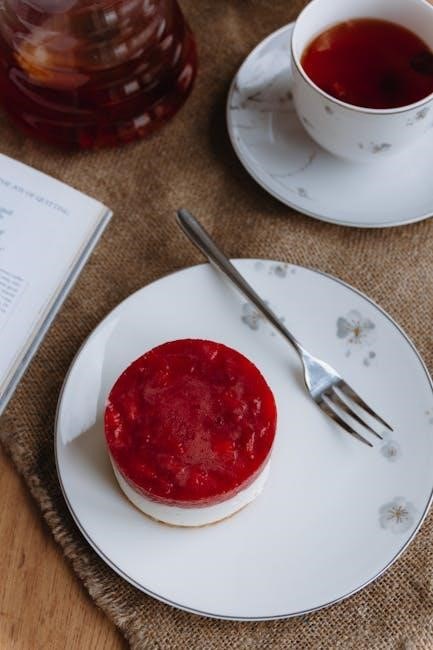
Tiered Cakes and Multi-Layer Servings
Tiered cakes offer a visually stunning and practical way to serve large gatherings. Each tier’s servings depend on its size and height, allowing flexibility for events of all sizes.
Calculating Servings for Tiered Cakes
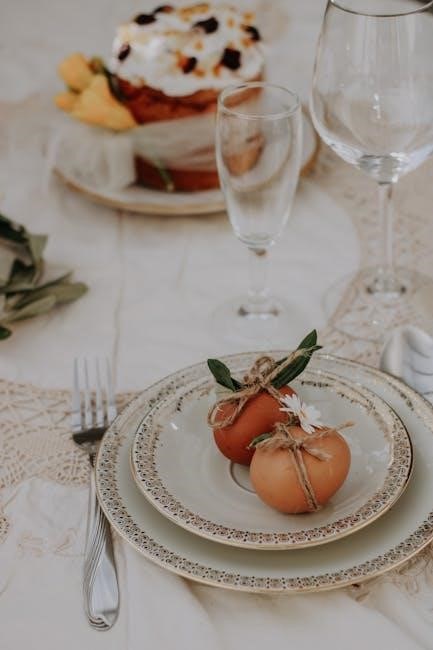
Calculating servings for tiered cakes involves measuring each tier’s volume and dividing by the standard serving size. A standard serving is typically 1 inch wide, 2 inches deep, and 4 inches tall. For example, a tier measuring 8 inches in diameter and 4 inches tall has a volume of 134.04 cubic inches. Dividing this by the standard serving volume (8 cubic inches) yields approximately 16.8 servings. Adjustments may be made for uneven slicing or varying layer heights. This method ensures accurate portion estimation for multi-layer cakes, making it ideal for weddings or large events where precise planning is essential.
Volume-Based Serving Estimation
Volume-based serving estimation calculates cake servings by measuring the total volume of each tier. Multiply the cake’s diameter by its radius and height to find the volume. Divide this by the standard serving size (1 inch wide x 2 inches deep x 4 inches tall = 8 cubic inches). This method ensures precise portion planning, especially for tiered cakes with varying sizes. For example, a 10-inch round cake (radius 5 inches) that’s 4 inches tall has a volume of 628.32 cubic inches, yielding about 78.5 servings. This approach is ideal for multi-layer cakes, providing an accurate way to estimate servings based on size and height.
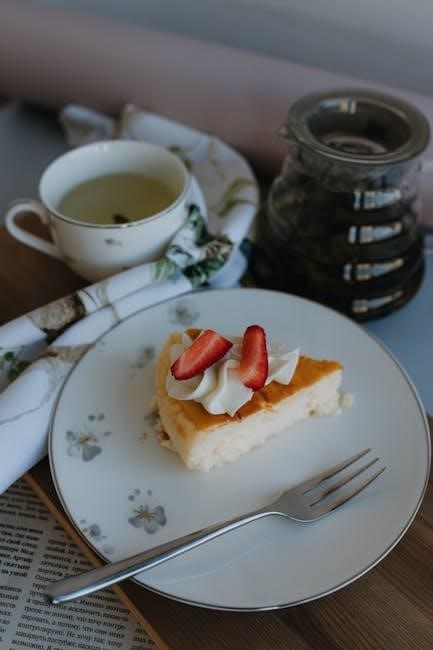
Tools and Techniques for Even Cake Slicing
Proper tools like serrated knives and cake turntables ensure clean, even cuts. Techniques such as measuring slices and using guides help achieve uniform portions for consistency.
Using a Serrated Knife for Clean Cuts
A serrated knife is essential for achieving clean, even slices of cake. Its toothed edge ensures smooth cutting without tearing the cake. To use it effectively, gently saw through the cake in a smooth, steady motion, applying light pressure. This technique prevents crumbling and ensures precise portions. For uniform slices, use a ruler or measuring guide to mark equal widths before cutting. Serrated knives work best when slicing cooled cakes, as heat can cause the blade to drag; Clean the knife between cuts to avoid transferring crumbs or frosting. Proper knife maintenance and technique ensure professional-level results, making every slice look appealing and consistent. This method is especially crucial for tiered or multi-layer cakes, where presentation matters most.
How to Use a Cake Turntable for Accuracy

A cake turntable enhances precision and efficiency when slicing cakes evenly. Place the cake on the turntable and spin it slowly while cutting horizontally with a serrated knife. This allows consistent access to all sides, ensuring uniform slices. For tiered cakes, position each tier on separate turntables or stack them securely. Use the turntable to align each tier’s slices symmetrically. Marking the cake with toothpicks at equal intervals can guide your cuts. This tool minimizes waste and ensures every slice is identical, perfect for events requiring precise portion control. Regular cleaning of the turntable prevents crumbs from affecting subsequent slices. By leveraging a turntable, you achieve professional-level accuracy and presentation in every cake serving scenario;
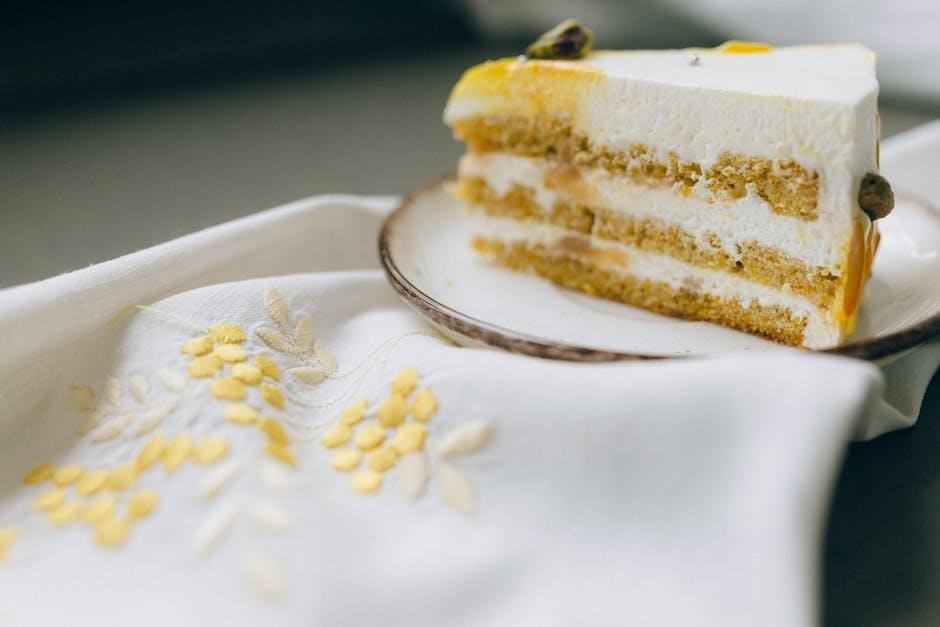
Serving Cakes at Special Events
Ensure your cake shines at weddings, parties, or gatherings. Proper portioning, elegant presentation, and timely serving are key for memorable experiences. Plan sizes and slices according to guest count and event type for a flawless celebration.
Wedding Cake Serving Etiquette
Wedding cake serving etiquette emphasizes elegance and precision. Typically, wedding portions are smaller, around 1×2 inches, ensuring each guest receives a fair share. The cake is usually served after the main meal, following speeches or toasts. Proper coordination with the venue ensures timely delivery and presentation. The wedding party is often served first, with the bride and groom traditionally feeding each other the first slice. For larger weddings, tiered cakes are ideal, allowing for efficient serving while maintaining visual appeal. Always consider dietary restrictions and offer alternatives if needed. Proper storage and handling of leftovers are also crucial for post-event distribution. This ensures a seamless and memorable experience for all attendees.
Party Cake Serving Tips
When serving cake at a party, consider practical and visually appealing strategies. Party portions are typically larger than wedding servings, around 1.5×2 inches, ensuring guests are satisfied. Labeling cake sizes and flavors can streamline service. Using a cake turntable allows for even slicing and easy access. Pre-slicing the cake before guests arrive saves time and reduces congestion. Offering variety, such as multiple flavors or dietary options, enhances guest experience. For outdoor events, shield the cake from direct sunlight to prevent melting. Assigning a dedicated server or using a self-serve station maintains order. Finally, prepare for leftovers by having containers available. These tips ensure a smooth, enjoyable cake-serving experience for any celebration.
Special Considerations for Cake Servings
Consider dietary restrictions like gluten-free or vegan options. Adjust portion sizes for children or large appetites. Store leftovers in airtight containers to maintain freshness and flavor.
Dietary Restrictions and Portion Adjustments
When serving cake, consider guests’ dietary needs such as gluten-free, vegan, or sugar-free options. Adjust portion sizes for children or those with larger appetites. For special diets, ensure alternative treats are available. Clearly label portions to avoid cross-contamination. If offering multiple options, allocate separate serving areas to prevent mixing. For events with diverse dietary needs, consult guests in advance to plan accurately. Store leftovers in airtight containers to maintain freshness and flavor. Always prioritize food safety and guest preferences for a memorable and inclusive experience.
Storing Leftover Cake Properly
To keep leftover cake fresh, store it in an airtight container at room temperature for up to 2-3 days. For longer storage, refrigerate and consume within 5-7 days. Freeze for up to 3 months by tightly wrapping in plastic wrap or aluminum foil. Thaw frozen cake in the fridge overnight to maintain moisture. Ensure the container is clean and dry to prevent mold. Avoid storing near strong-smelling foods to preserve flavor. Use wax paper or parchment between slices to prevent sticking. Label containers with dates for easy tracking. Proper storage ensures your cake remains delicious and safe to enjoy later.
